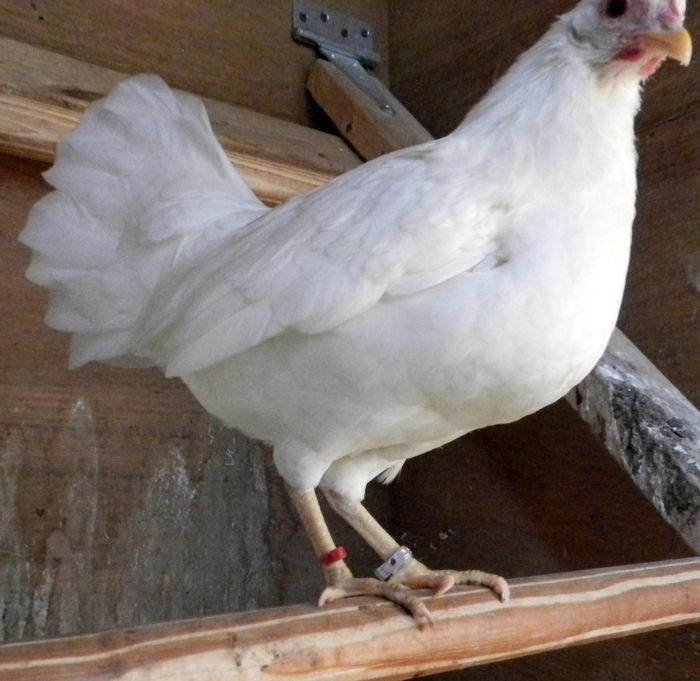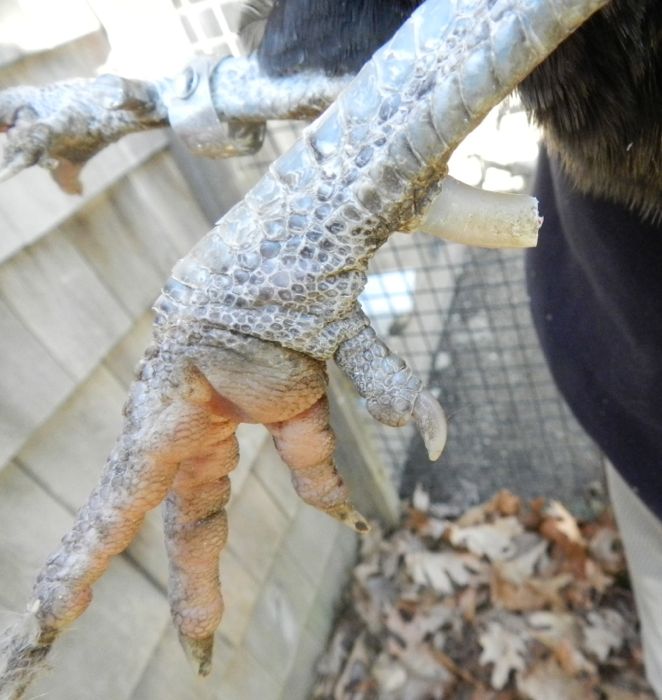When it comes to animals there are no absolute hard and fast rules. When you have a flock of chickens, you’ll find your assumptions upended. For example, those of us who choose to keep only hens do so to avoid traits that we find undesirable in roosters. We want quiet. Having only girls, though, is no guarantee of a muted flock; it’s usually the roosters that crow, but once in awhile you’ll have a hen that loudly yodels. Some hens can really make a racket.
We like our hens for their feminine looks. Here are Betsy’s clean and dainty legs.
Roosters have long, sharp and dangerous spurs. Hens do not.
Wrong, again. All chickens have buds on their legs from which spurs can grow. In most hens they remain latent, but spurs are not that unusual in the females of Mediterranean breeds. Polish hens often sprout them. When Tina and Siouxsie were about two years old I noticed that they were developing spurs. Over the years their spurs seemed to keep growing, like fingernails, but slower. Still, they got longer and longer. I left the spurs be, but then the other day I noticed that Tina was strutting like a rooster. Now what was going on with her? I watched and I realized that her spurs had grown so long that in order to walk she had to pick her feet up and out of the way of each protuberance.
Can you believe the size of that spur? It was time to give both Polish hens a spur trimming. I got out the tools. Those are dog nail clippers, which are perfect for clipping round bird toenails. Since spurs do have a blood supply, I always keep blood stop powder at the ready in case I nick it.
Steve held each hen. I carefully trimmed each spur. I did this in small increments, about 1/8-inch each snip, so that the nails wouldn’t split and so that I would remove only the dead cartilage and not cause bleeding.
Success!
It’s much easier to walk now.






I had a rooster that had no spurs at all. We all thought he was a she until he started crowing every morning.
Sounds like a fine rooster!
WOW, I can’t believe how much you were able to remove. I really appreciate this post. 16 weeks ago I picked up three Andalusians and I know they can grow spurs. Now I’m more confident that I can deal w/ them if I have to. Spurs really scare me. I don’t know why.
On a chicken-keeping forum I once read a post from a bewildered owner about his “rooster” (a noisy bird with a beautiful tail, tall comb and spurs). The owner enquired if he should take his “sick rooster” to the vet: the bird must be ill because “he” had layed an egg that morning. We made the same mistake when we first hatched chicks, believing, thanks to spur buds, that we had 3 girls and 2 boys. It turned out to be the other way round completely.
Great post! For Amy- spurs should scare you- I am sporting a 5″ scar on my right forearm from a rooster that I had to handle at our county fair where I am a superintendent. Everything was going along fine until someone came up and startled the bird as I was removing him for pylori testing. He caught my arm with that spur and laid it open. Good thing we keep a first aid kit and boy did that sting! :)
Ouch!
So funny you should post this story today . . . I have a 6 year old Ancona hen that has just started crowing in the last month or so . . . Not sure what her story is but it does make me laugh every time I hear her . . . crazy hen!
Hens have only one working ovary. If it becomes diseased or injured, then the hormone balance changes and hens can take on some male characteristics, like crowing.
It be funny if one day either Tina or Siouxsie started to do that one day in their old age,and their top knots instead of looking like afros, started to look like a 80’s hair band.
Ha. This sounds like a description of post-menopausal women as well. Ovaries ‘cold’ (as a medical intuitive once remarked) and the hormone balance shifting towards more androgenous traits. I have definitely become louder and bossier since The Change. I haven’t crowed yet, but now I’m thinking about it.
Some of us say that our older, non-laying hens are going through “henopause.”
Ages and ages ago, when the flock here was reduced to hens, one of them began crowing in the morning. Not very well, but she tried. Maybe a hormonal imbalance, but I wonder if it isn’t programmed somewhere, “Nobody’s crowing! Maybe I’d better fill in?”
(Among lions, the dominant male has the darker mane. Somehow when he realizes he’s dominant, his body responds by producing this dark mane. The mind-body connection-!)
What was that old saying,
“Whistling girls and crowing hens/soon will meet with bitter ends!”
When do roosters typically get spurs, I have a Mottled Houdan Roo, he is crowing but no spurs yet he is about 7 months old
Right about now! You should be seeing bumps on the legs. They’ll get bigger, unless you luck out and have a rooster without spurs – like Charli had – read that comment.
I should get so lucky, to have one without spurs but I did get him to protect my flock so he does need his spurs, but he is pretty docile and gentle so hopefully he will never feel the need to use them on a human or one of my 3 dogs or cat,
Wow! That really was huge. So glad she is more comfortable after the trimming.
Speaking of hens having male characteristics. We have four hens. When I feed them treats, three of them run to the food while one of my barred rock girls ( her name is Dr Oliver -my son named her) ALWAYS stands back and lets them eat first. On the occasion that my Westie sniffs the border of the chicken run trying to see what they are getting….that same girl stands guard and will peck my dogs nose if she gets too close. All while the other three are oblivious and stuffing their beaks with snacks. Is it normal for one hen from the flock to be the protector? I’ve been so curious about this. She’s so sweet and never aggressive with us at all. When I go in the run, she jumps up on the roost branch and sings to me. :)
I really appreciate this post! My 7 year old EE roo has crazy spurs. Everyone tells me I could cut them off, but that sounded so scary to me!! This is so helpful. Thank you!